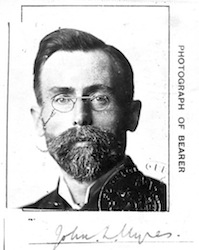His interest in Linear B began in 1936 when he went with a school group to an exhibition celebrating the 50th anniversary of the British School at Athens. Sir Arthur Evans, then 85 years old, happened to be present in the gallery and showed the boys his finds from Knossos, including the Linear B documents. His teacher remembers Ventris asking: “Did you say the tablets haven’t been deciphered, Sir?” Thus began a life-long fascination with “the Minoan problem”.
Ventris wrote to Evans — who kindly wrote back — and soon published his first article on the subject, when he was just 18 years old. This came out in the American Journal of Archaeology in 1940. The same year, Ventris began a course at the Architectural Association School in Bedford Square to embark on his chosen profession as an architect’ (http://www.classics.cam.ac.uk/faculty/research_groups_and_societies/mycenaean_epigraphy/decipherment/life_of_ventris/).
During the WWII, Ventris ‘served as a navigator’ (ibid) while Sir Arthur Evans died ‘just in time to be spared news of the occupation of Crete’ in 1941. But Ventris ‘never forgot the Aegean scripts problem’ (ibid) and after the death of Evans, he ‘corresponded thereafter with Sir John Myres, who had been entrusted by Evans with the publication of Scripta Minoa II, the Linear B tablets of Knossos’ (ibid).
 |
| Sir John Myres |
After the war, it still took Ventris a few more years to settle things back on track. He was further mobilised to Germany due to this excellence in 1946, and after that he had to concentrate for his architect degree, which he finished in 1948. Through these years, Ventris visited John Myres in Oxford twice and in both occasions he had to decline the invitation for helping publication of Scripta Minoa II due to his busyness. Interestingly, Ventris had an opportunity to meet Alice Kober, who was brought in by Myres, in the second occasion on August 1948. Though this was the sole opportunity for Ventris and Kober to see each other, it is said that the meeting ‘was not a great success, and… It has been said that Ventris withdrew because, as an amateur, he was intimidated by academia’ (ibid) while it would be worth adding that ‘many academics themselves found Kober and Myres rather formidable!’ (ibid) Furthermore, other factors that made this meeting unsuccessful are allegedly pointed out as it follows: there was a crucial ‘disagreement over how the tablets should be classified’ (ibid) between Ventris and others and in this, ‘he was justified’ (ibid) when ‘a new set of transcriptions were later prepared by himself, (John) Chadwick and (Emmett) Bennett’ (ibid). As for compatibility between Ventris and Kober, some argues that ‘each underestimated the other deeply… She underestimated him because he was an amateur, and he underestimated her because she was a woman’ (http://www.bbc.co.uk/news/magazine-22782620).
Fore reading the text in full: http://wrex2009.wordpress.com/2013/08/26/discovery-and-deciphiering-of-the-crete-inscriptions-liner-b/
No comments:
Post a Comment